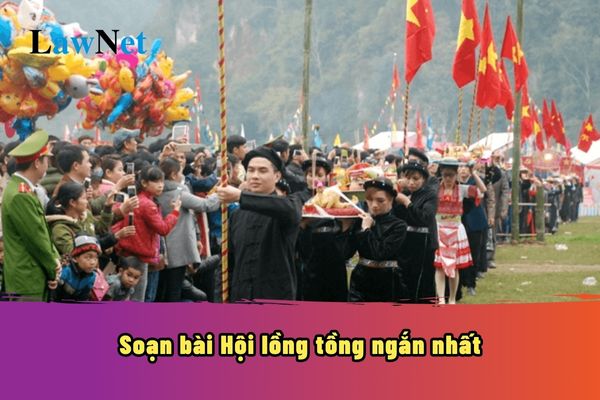What are the guidelines for preparing the shortest lesson "Hội lồng tồng"? Does the 7th-grade Literature curriculum in Vietnam cover the meaning of common Sino-Vietnamese elements?
What are the guidelines for preparing the shortest lesson "Hội lồng tồng"?
The excerpt "Hội lồng tồng" brings us a vivid and colorful view of a traditional festival of the Tay and Nung ethnic communities. This is a valuable document that helps us better understand the culture and people of Vietnam.
7th-grade students can refer to the following sample lesson "Hội lồng tồng":
|
Sample lesson "Hội lồng tồng" 1. General Introduction |
*Note: Information is for reference purposes only./.

What are the guidelines for preparing the shortest lesson "Hội lồng tồng"? Does the 7th-grade Literature curriculum in Vietnam cover the meaning of common Sino-Vietnamese elements? (Image from the Internet)
Does the 7th-grade Literature curriculum in Vietnam cover the meaning of common Sino-Vietnamese elements?
Under Section 5 of the General Education Program in Literature issued along with Circular 32/2018/TT-BGDDT, the required outcomes for general writing skills in the 7th-grade Literature curriculum are as follows:
VIETNAMESE KNOWLEDGE
1.1. Idioms and proverbs: characteristics and functions
1.2. Terminology: characteristics and functions
1.3. Meaning of some common Sino-Vietnamese elements (e.g., quoc, gia) and the meaning of words formed with those elements (e.g., quốc thể, gia cảnh)
1.4. Context and meaning of words in context
2.1. Numerals, adverbs: characteristics and functions
2.2. Main and adverbial components of a sentence: expanding the main and adverbial components with phrases
2.3. Use of ellipsis (...): (along with comma, indicating many similar objects or phenomena not yet listed; expressing incomplete or interrupted speech or pauses; stretching the rhythm of the sentence, preparing for the appearance of a word or phrase indicating unexpected or humorous, sarcastic content)
3.1. Rhetorical devices of hyperbole and understatement: characteristics and effects
3.2. Coherence and continuity of text: characteristics and functions
3.3. Text types and genres
- Narrative text: a narrative essay recounting real events related to historical characters and events
- Expressive text: an expressive essay; four-lined, five-lined poems; a paragraph recording feelings after reading a four- or five-lined poem
- Argumentative text: the relationship between opinion, reasoning, evidence; an essay arguing a problem in life; an analysis of a literary work
- Informative text: Footnotes and bibliography; explanatory essay used to explain a rule or law in a game or activity; report text; summary text of varying lengths
4.1. Language of regions: understanding and appreciating linguistic differences among regions
4.2. Non-verbal communication tools: images, data
Thus, the 7th-grade Literature curriculum in Vietnam covers the meaning of common Sino-Vietnamese elements.
What literary knowledge does the 7th-grade Literature curriculum in Vietnam cover?
According to Subsection 2, Section 5 of the General Education Program for Literature issued with Circular 32/2018/TT-BGDDT, the 7th-grade Literature curriculum covers the following literary knowledge:
- The cognitive value of literature
- The topic and theme of texts; the relationship between details and theme, how to identify the theme of texts; the attitude and sentiments of the author expressed through the text
- Summary of texts
- Form of proverbs
- Topics, events, situations, plots, space, time, and characters of fables and science fiction stories
- First-person narrator and third-person narrator; the effect of each type of narrator in a storytelling
- Some formal elements of four- and five-syllable poetry: the number of sentences, words, rhyme, rhythm
- The lyrical quality, the self, the language of essays, and prose
- Life experiences and the understanding of literature

